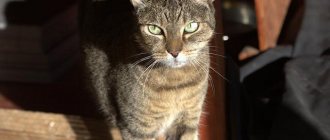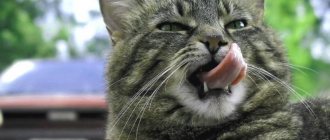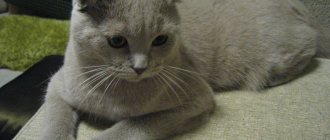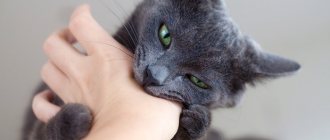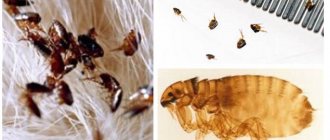Cats are active and very playful animals. Of course, there are extremely lazy individuals, whose most “outstanding” achievement is constant sleep and continuous eating, but still not a single healthy cat will refuse to run properly. Sometimes animals flirt in such a way that they do not behave quite “appropriately”.
And it happens that at this moment short-term convulsions develop: in a cat they often last a couple of seconds, which is why the owners do not have time to understand anything. Meanwhile, any convulsions and seizures, even if they last no more than a couple of seconds, are an extremely bad sign, indicating pathologies that are dangerous to the health and life of the animal.
What are cramps
The first thing all owners of “convulsive” animals need to know is that seizures and other seizures are not a disease in themselves, but they indicate pathological functioning of the brain or the nervous and muscular systems as a whole.
Note that convulsions most often begin in two opposite situations: either the cat is absolutely calm before it, or it is actively moving. It is almost impossible to predict their occurrence.
Types of seizures
Regardless of the cause, all seizures can be divided into two large categories: local and generalized (generalized). Let's consider these options in more detail.
Generalized seizures
They are easiest to identify even for the most inexperienced owner: in such cases the cat can simply fall, shaking all its limbs, it is clear that the animal is in a semi-conscious state. In many cases, severe tremor of the facial muscles is observed, drooling profusely, and involuntary urination and defecation are observed.
As a rule, generalized convulsions rarely last more than three minutes. More precisely, cats rarely survive longer attacks. In many diseases (more precisely, in their first stages), soon after convulsions the animal fully recovers and often behaves as if nothing had happened. Rapid breathing will indicate what has happened.
Interesting! Such signs indicate severe brain damage - your pet may indeed not remember the seizures, since at that time she was in a state of “twilight consciousness.”
In other cases, immediately after an attack, the animal looks confused, depressed, and may behave inappropriately for some time. During this period, it is very desirable to provide the pet with complete peace and absence of stress, since any negative environmental factors can provoke a repeat attack.
Local convulsions
They are more typical for cats (if we compare them with dogs). Seizures in this case can be very difficult to detect. The problem is that not in all cases the cat’s hind legs (or forelimbs) actively twitch. Everything is much more complicated.
As in the previous case, cats may experience a sharp increase in salivation, foam at the mouth, twitching of the eyelids or facial muscles, excessive vocalization (the cat constantly and loudly screams), as well as strange and abnormal movements of the head and/or limbs.
In severe illnesses, seizures gradually progress to generalized ones, but situations are more common when their frequency and duration increase (first the front legs twitch, and then all the limbs).
Important advice: if you see that something is definitely wrong with your cat, it is very advisable to record this moment on video.
Let us note that even experienced veterinarians are not always able to determine the root cause of seizures if the appearance of the latter is caused by some difficult to diagnose pathologies of the nervous system. In such situations, encephalography is vital. This technique (expensive and rarely used in veterinary medicine) helps to accurately determine the state of the animal's brain.
But! It happens that seizures are not a sign of some serious pathology. Let's give a simple example. Cats, of course, cannot be considered avid swimmers, but sometimes they have to be washed, or the animal ends up in a deep puddle. Local “twitching” after bathing is a relatively normal phenomenon. This happens even to professional swimmers. Treated with peace and rest.
Primary and secondary seizures
Other veterinarians prefer to divide seizures differently: also into two types, but they are guided by the root cause and time of their occurrence. In this case, all seizures are divided into primary and secondary.
The latter are found much more often than the primary ones in veterinary practice. Simply put, secondary seizures are a consequence of some serious illness acquired by the cat during its life. These include: brain tumors, inflammation or infections (encephalitis), consequences of injuries, strokes (yes, they happen in animals too). Secondary status is indicated by the presence of other signs of the disease, such as vomiting, diarrhea, an increase or sharp decrease in body temperature, etc.
With primary seizures, they are also not the disease itself, but indicate severe functional disorders of nervous activity. In particular, persistent and unexplained seizures (which are not, however, epileptic) may indicate an imbalance between the number of “excited” and “inhibited” neurons in the brain, or some problems with the volume of neurotransmitters produced by the body.
In such cases, the first seizures are observed from an early age. However, such animals usually do not live to a relatively mature age. It is believed that no more than 29% are primary. As a rule, all diseases that cause their appearance are genetically determined and are not always diagnosed (due to the lack of appropriate technical equipment).
What are the symptoms of a seizure in a cat?
Most people are familiar with the sensation of muscle cramps accompanied by sharp pain. Cats experience the same sensations when they feel muscle cramps. At the same time, it is clear that their paws make erratic movements, or vice versa - they are tense, curled under the stomach, and their fingers are clenched.
It is clear that the cat is scared, she is in pain, she screams loudly, but at the same time she does not allow the owner to touch her. At the time of a convulsive attack, the cat’s pupils dilate, and the whiskers may bristle, and sometimes are pressed tightly to the muzzle. If pain occurs in the hind legs, the cat may fall, and at this moment it alternately pulls its legs in length.
The cat may try to get up but fails. But most often she is afraid to move. In more severe cases, the cat may foam from its mouth and may involuntarily wet itself. At the same time, she does not respond to the owner’s call, simply not recognizing him. Signs of aggressiveness may appear.
After the attack ends, the cat calms down and behaves as usual. However, sometimes for some time she may not recognize her home or find places that are familiar to her.
Some cat owners who have not previously observed this behavior in their pet do not contact the veterinarian until they see a recurrence of the seizure attack.
This is a huge mistake - you need to show your pet to the veterinarian even if the animal looks vigorous and healthy. The cause of convulsive seizures in a cat can be a wide variety of diseases, the list of which includes those that are extremely life-threatening.
Causes of seizures in cats
The causes of seizures in cats are extremely varied and numerous, and therefore it is unrealistic to describe them in one article. They can be caused by both the most “extravagant” and rare degenerative pathologies of the brain, as well as more “mundane” causes (like poisoning).
Let us list the predisposing factors that practicing veterinarians most often have to deal with:
- Seizures are very characteristic of epilepsy , but with this disease they do not develop in 100% of cases.
- They are also frequent manifestations of poisoning. In particular, if strychnine enters a cat’s body, convulsions can be triggered even by birdsong (hyperexcitability of the nervous system).
- Oncological diseases (a common cause of seizures in an old cat).
- Lack of vitamin B1. Often found in cats. The reason is excessive feeding of pets with raw river fish. The fact is that this product contains a large amount of thiaminase. This is an enzyme that destroys B1. Considering that this vitamin is extremely important for the functioning of the central nervous system, the occurrence of seizures in such situations is not surprising.
- Cramps in general are often associated with nutrition. So, if a cat’s body does not receive the proper amount of vitamin B6 and magnesium, nothing good should be expected.
- Very often, seizures develop with renal failure . The reason is a drop in the level of free calcium in the blood serum. In such cases, the normal conduction of neuromuscular impulses is disrupted, which leads to uncontrolled contractions of muscle fibers.
- Allergic reactions. In particular, after vaccination (due to intolerance to the components of the drug).
- Hypertension (and in some cases also hypotension). Critically high or low blood pressure does not have the best effect on brain function.
- Reaction to some medications. In particular, convulsions after anesthesia can hardly be called an absolutely normal phenomenon, but it still happens quite often.
- Sudden temperature changes. In particular, cats have a very (!) hard time withstanding heat and stuffiness.
- Diabetes . One of its characteristic signs is precisely seizures that develop when blood sugar levels drop to a critically low level.
- Problems with the endocrine glands. Thus, pathologies of the thyroid gland can lead to too low levels of calcium in the blood. The result is tetanic convulsions. During estrus or immediately after childbirth, the likelihood of such attacks increases markedly.
Let's describe some of these reasons in a little more detail.
Causes
Having good flexibility, cats have a perfect muscular system that is not prone to spasms and cramps. They easily control the work of each muscle group. Therefore, the appearance of convulsive conditions most often indicates pathology and requires contacting a veterinary service.
Spasms as a normal reaction of the body
Seizures in a cat that occur during sleep are a normal reaction of the body. Sometimes you can notice how a kitten that is sleeping has its hind legs, ears, and eyelids twitching. This reaction occurs when the animal has vivid dreams. Scientists conducted a series of neurophysiological studies, during which they found that cats, after a day full of impressions, dream of hunting, exploring the area, and communicating with their fellow tribesmen. This state during sleep does not pose a danger to the animal’s health and disappears without a trace after waking up.
Spasms as a pathological reaction
Diseases of which spasms are a symptom can be divided into several groups. All of them represent the reasons for the appearance of this violation:
- neurological diseases occurring with brain damage;
- consequences of metabolic disorders;
- disruption of brain activity as a result of the action of toxic substances;
- other conditions and pathologies.
Neurological diseases with brain damage
There are a lot of diseases of the nervous system that cause complications in the brain. These are infectious or organ-specific pathologies. Their neurological manifestations are approximately the same, although the nature of the seizures may differ. In order to understand what their causes are, a high-quality diagnosis is necessary.
Tick-borne encephalitis
This is a viral infection transmitted by ixodid ticks. All animals are susceptible to disease, regardless of whether they go outside. If an embedded tick is found, it must be removed immediately. But if infection has already occurred, the first symptoms will soon appear: low-grade fever, refusal to eat, intoxication. Later, neurological disorders appear: paralysis, convulsions during sleep and while awake, numbness.
An acute condition is life-threatening for the animal, especially if it has a weak immune system. Symptomatic treatment is used aimed at restoring the immune system. Rest and long sleep are required. This will help the body's defenses cope with the virus. If this does not happen, a transition to the chronic stage or the development of complications is possible.
Hypoxia
The main factors of hypoxia or oxygen starvation of tissues are acute cardiovascular and respiratory failure. It is characterized by many diseases of the cardiovascular and respiratory systems. Main signs: shortness of breath, pallor and cyanosis of the mucous membranes. The progression of the pathology provokes involvement of the brain, and hence the appearance of neurological signs - seizures, paresis. The stage of excitement is replaced by the stage of depression. Without help, the animal may die. Resuscitation measures are needed to alleviate the condition. The disease then needs to be treated according to its cause.
Tumors
Benign or malignant brain tumors are a fairly common cause of seizures. As the tumor grows, pressing on surrounding tissue, neurological symptoms also continue to increase. Along with a convulsive attack, loss of consciousness, convulsions, walking in a circle, and behavioral reactions may be observed. The cat needs to be seen by a doctor as soon as possible, since how quickly the diagnosis is made and surgery is scheduled determines how long the animal will live and what its quality of life will be.
Head injuries
The main causes of head injuries are falls from a height, dog bites, injuries in road accidents, being hit by doors, and others. The first symptoms of injury are bleeding from the nose and ears, loss of consciousness, and loss of coordination. Quite often, seizures can occur as a reaction of the body to brain damage. Therapy is used in accordance with the severity of the animal's condition. Oxygen therapy is used by placing animals in an oxygen chamber and artificial ventilation. It is extremely important for the animal to be at rest during the treatment period.
Epileptic seizures
This disease is rare in cats. In most cases, it is congenital (genetic pathologies). The disease is expressed in the appearance of convulsive seizures, which occur suddenly and last for some time. In cats, seizures due to epilepsy are often generalized. The disease itself does not pose a threat to the life of the animal. Most often, cats suffer from injuries. Therefore, the owner is required to do everything to prevent this from happening.
The animal must be shown to an experienced veterinarian. It is important for the doctor to find the cause of the disease, since in this case the disease can be completely cured. If a cat is diagnosed with “idiopathic epilepsy,” it will be treated for life with antiepileptic drugs that alleviate the animal’s condition.
Consequences of metabolic disorders
Metabolic pathologies that cause cramps and muscle spasms include the following diseases.
Avitaminosis
Avitaminosis (vitamin B1 deficiency) causes a dangerous disorder - metabolic encephalopathy. In the absence of thiamine, the brain stem is affected. The reason is the constant presence of raw fish in the diet. Thiaminase contained in it prevents the entry of vitamin B1 into the body. The main symptoms are loss of coordination of movements, tremors of the limbs, convulsions. Starting in the hind legs, the spasms also spread to other muscles, gradually involving the entire body.
Hypoglycemia
A sharp drop in blood sugar in a cat with diabetes causes loss of consciousness and convulsions. The condition is relieved by administering glucose through a dropper, by injection or orally.
Poisoning
When toxic substances are swallowed or inhaled, or household chemicals enter the body, toxic substances affect the nervous system through the blood. Severe helminthiasis also leads to poisoning. The main way to eliminate this situation is to detoxify the body. The animal is provided with rest, the stomach is washed, and, if necessary, the blood is purified.
Other conditions and pathologies
Death throes
Seizures usually occur in cats before death. Agony (near-death state) is accompanied by acute hypoxia, which indicates a decrease in heart rate and respiration. Muscles suffer from lack of oxygen. At this point, the cat may experience severe pain. In such cases, the most humane decision is often to euthanize the animal.
Other reasons
Intolerance to anesthetics administered to kittens during various medical operations and manipulations can manifest as symptoms of allergic reactions, cardiovascular disorders, hypoxia and convulsions.
Seizures may occur after sterilization or after childbirth. These processes are a strong stress for the body. Castration, in addition, causes severe hormonal disruption.
Kidney pathologies are difficult to treat and are prone to relapse. In case of kidney failure, the body is poisoned by waste products. As a result, autoimmune reactions and inflammation appear. Later, symptoms of damage to the central nervous system appear.
Convulsions during poisoning
As mentioned above, in case of poisoning, convulsions are a completely “normal” phenomenon. Of course, this is not always the case: such seizures are caused only by toxins that are part of the “convulsive” group. Note that in such cases, everything is usually in order with the animal’s nervous system. If you manage to remove the poison from your pet’s body in time and relieve convulsive seizures, there is a high chance of saving not only the life, but also the health of the cat.
It should be remembered that in case of poisoning, the intensity and duration of convulsions are sharply reduced immediately after gastric lavage or administration of blood substitute fluids (i.e., when the concentration of the toxin in the body decreases).
The most dangerous poisons that can cause such seizures are:
- Strychnine.
- Cicutotoxin.
- Bicycloorthophosphates.
- Silatranes.
- Cis-5,6-dichloro-2,2-dicyano-3,3-bis(trifluoromethyl)norbornane.
- Triazadisulfonoadamantane.
All of them are not very common, but seizures, the appearance of which is caused by poisoning, are quite common.
Why does this happen? The thing is that the same salts of heavy metals, destructive for all mammals, cannot cause seizures by themselves. But they can kill the liver, as a result of which the animal’s blood is literally “overwhelmed” by a stream of toxins. The latter, when they enter the blood, cause various and very severe side effects. They often cause chronic renal failure later, and we already know that kidney failure leads to problems with calcium levels in the blood...
Seizures caused by metabolic disorders
Pathologies of organs and endocrine glands in cats can also cause seizures. This is due to a violation of the metabolism of individual elements, inflammation and intoxication phenomena caused by untimely removal of decay products from the body.
Eclampsia
A decrease in the concentration of calcium in the blood serum to a critical level in pregnant and lactating cats is manifested by changes in behavioral reactions and frequent painful convulsions. First, the hind legs and facial muscles twitch. Gradually, other parts of the body are involved in the process, attacks become more frequent and intensified.
The cat falls over on its side, makes uncoordinated movements, and the state of apathy is replaced by sudden excitement. Severe forms end in coma and death.
Hypoglycemia
A sharp drop in blood sugar can cause clonic-tonic seizures, similar to epileptic seizures. This usually occurs after a large dose of insulin is injected for diabetes.
In this case, the glucose level should be immediately stabilized by oral administration of a sweet solution.
Kidney failure
The reasons for the development of this complex of symptoms may be autoimmune diseases, inflammation, infectious lesions, and poisoning. An attack can develop after anesthesia administered without observing the dosage.
Due to impaired elimination of toxins during renal failure in cats, symptoms of central nervous system damage rapidly increase, expressed in convulsions and paralysis. And when the disease passes the terminal stage, destructive processes begin in the brain, leading to the death of the animal.
Old age
Seizures in an old cat may be a consequence of a chronic form of pathology. It can form as a result of improper feeding, infections, poisoning or urolithiasis that developed after sterilization. The degeneration of kidney tissue in chronic renal failure is considered irreversible, therefore modern veterinary medicine does not have methods for treating the disease.
Convulsions before death
Alas, we are all mortal. Our pets also have their own time limit. Seizures immediately before death are common. Is it possible to somehow understand that this particular seizure is the last in the cat’s life? Most likely (with the exception of hyperacute forms of diseases) this is real.
The seizures themselves in this case are the result of severe (and incompatible with life) changes in the cat’s body. The blood supply and oxygenation of the brain are disrupted, neurons die in the thousands, and normal life activity ceases.
As a rule, a cat does not die “out of the blue.” If he was ill for a long time, suffering greatly, or received a serious head injury in a fall or from a collision with a car, then his death, an extremely sad event, will definitely not be sudden.
Death spasms differ in their duration. From time to time, the appearance of lucid windows is noted, when consciousness returns to the animal for some time. In addition, such convulsions, unlike the “life” varieties, gradually subside, but the cat’s condition noticeably worsens in the intervals between them . Before immediate death, there are relapses of strong, powerful muscle spasms, when the cat's body can literally arch.
Convulsions or epileptic seizure?
We have already mentioned epilepsy several times. What is it and how can you distinguish epileptic seizures from “regular” seizures? Currently, many researchers propose to consider it not one disease, but a syndrome that combines different pathologies that can cause functional disorders of brain activity. Be that as it may, this disease is accompanied by strong and characteristic seizures, which nevertheless develop over several years (there are cases of rapid progression, but they are not so common).
When it comes to differentiation, things are complicated. It is believed that with a single seizure it is impossible to talk about epilepsy, but nevertheless seizures (a characteristic sign of both seizures and epilepsy) become more frequent over time, so they are not a reliable differential sign. Without a number of diagnostic studies (which we will discuss below), it is impossible to make an accurate diagnosis.
But! In everyday life, it is believed that an epileptic seizure cannot develop in a dream: such seizures are more typical during periods of wakefulness. Ordinary convulsions occur at any time.
Diagnostics
Unfortunately, there are many problems with diagnosing the causes of sudden seizures in veterinary medicine: often clinics simply do not have the equipment to reliably identify the primary disease (however, it is often not available in “human” hospitals either). In addition, in such cases it will not be possible to get by with a simple examination and history taking. A number of detailed diagnostic studies need to be carried out.
First, a blood test, including toxicology and biochemistry, is extremely important. The latter is needed to assess the condition of the liver and kidneys (we have already written about their role in the development of seizures above). Older cats should also have their blood pressure checked several times. Severe deviations from the norm often indicate diseases of the thyroid gland, kidney failure, as well as pathologies of the heart and blood vessels. All of them can directly contribute to the occurrence of seizures.
An MRI and an encephalogram are strongly recommended. These techniques make it possible to accurately assess the state of the animal’s central nervous system. They help diagnose intracranial causes of seizures, such as brain tumors, encephalitis, stroke, or some congenital malformations. Despite the complete painlessness of the procedure, anesthesia or the administration of powerful sedatives is desirable.
In the most complex and doubtful cases, they also resort to examining the cerebrospinal fluid, as it helps to identify many infectious diseases that affect the nervous system (listeriosis, for example). Of course, this technique is not cheap. In addition, there is always a certain risk that if it is performed incorrectly, the cat will remain disabled.
Therefore, veterinarians more often resort to more gentle (and cheaper) methods, including radiography and ultrasound. Ultrasound is used more often as it allows us to assess the condition of soft tissues. If for some reason it is impossible to carry out this procedure, they resort to contrast fluoroscopy.
It should be noted the importance of repeated tests and studies for oncological causes of seizures. Even if the operation is successful, there is no guarantee that after some time the tumors will not “grow” again.
First aid
Is it really possible to do something for your pet at home? Although a seizure is a frightening experience for any cat owner, it is important to try to remain calm rather than intervene (this usually causes much more harm). Ensure that the cat is not at risk of injuring itself, for example by falling down stairs or a dresser.
Be sure to time the onset of the seizure. It is believed that relatively “harmless” convulsions last up to two minutes. If the seizure lasts longer than three minutes and your cat seems to be getting worse, call your veterinarian immediately.
Please note that you should not try to grab a “convulsive” cat with your bare hands. Your pet is not himself at this time, and therefore may be aggressive. In addition, when a cat has a cramp, it will easily rip you with its claws.
Veterinarians at this time advise wrapping animals more tightly in a soft blanket. And the point here is not in trying to warm the cat: with some types of seizures, this should not be done. But a “wrapped” cat will not fall out of nowhere, will not get hurt, and will not tear the owner’s hands to the bones (otherwise he will need first aid).
Important! Even after the condition has normalized, it is not recommended to leave the cat alone.
It is necessary to sit with the pet, talk to it tenderly, calming it down. However, the real need for reassurance does not always arise. In most cases, the animal still does not remember anything. In such cases, it is much more important to be closer in order to react in a timely manner if the attack recurs. Unfortunately, there is nothing else you can do for your pet. If the attack starts again, or you do not like the animal’s condition, call a veterinarian immediately.
Important! Never prescribe any medications yourself. You won’t be able to help the cat, but you can completely kill it.
However, some breeders talk about the permissibility of using Corvalol. A couple of drops of this product on the tongue will help calm your pet and ease subsequent seizures (if any).
Never give food or drink to an animal that has just had a seizure: water or food sometimes triggers a relapse, during which the cat can easily choke or choke to death. In addition, we recommend placing the cat in a room with a comfortable temperature, protected from drafts. This is especially important when cramps appear after surgery.
First aid for a cat with a seizure
The first rule is to act as quickly as possible. Seizures in a cat can be dangerous, in this case it is important to know what to do, not to get confused and not to hesitate: even a minute can cost your pet’s life.
It should be remembered that the animal can get hurt, so the first thing you need to do is remove unsafe objects: furniture, wires, dishes, etc. The condition is characterized by inappropriate behavior: the pet can bite and scratch even the owner, and not recognize the usual surroundings and conditions in the house.
There is no need to grab your pet during or after an attack: sudden movements can further injure the animal! You should quickly and carefully wrap your pet in a thick blanket and allow him to come to his senses.
It is recommended to protect your hands and take a thick blanket in which to wrap your pet. It is important to act quickly and carefully, to allow the animal to calm down; usually the attack lasts no more than 5 minutes. After the cat returns to its normal state, it may want to drink and eat - this is a normal reaction, you can prepare cool water and some food.
The next step is to contact a veterinarian: the frequency and intensity of involuntary convulsions can become dangerous, and the next attack can be fatal. An accurate diagnosis and effective treatment therapy can save your pet.
Treatment
Treatment of attacks should first of all imply the immediate elimination of their root cause (if one has been identified).
Drugs
Of course, it is impossible to cure neurological disorders in animals (as a rule), but achieving a stable lifelong remission is quite possible. Therapy is usually considered successful when the number of seizures has been reduced by at least 50%.
In cases where seizures are a consequence of severe disorders of brain activity, the animal will have to be on medication for life. In such situations, phenobarbital, levetiracetam, zonisamide, gabapentin and pregabalin are actively used.
Prevention
Prevention plays an important role, including protecting the animal from stress and other negative environmental factors.
In other cases, therapy involves immediate relief from the underlying causes:
- Hormone replacement therapy, etc. It may also be relevant when seizures suddenly develop after sterilization (i.e. removal of the ovaries or testes).
- Broad-spectrum antibiotics.
- Antidotes for poisoning.
- Antihistamines if seizures develop after an injection or other type of medication administration.
- Surgery for injuries or tumors.
- Chemical or radiation therapy for cancer.
And if therapy does not give any visible positive results, then what to do in this case? A repeated course of diagnostics is recommended. Reasons for positive changes include: misdiagnosis (most often), inappropriate dosage, or development of resistance to the effects of the drug.
Once again we emphasize the importance of lifelong therapy. So, if your cat’s seizures are explained by the degradation of his thyroid gland, the use of synthetic hormonal drugs should not be interrupted: the animal’s body can no longer produce its hormones.
Even when switching your pet to another medicine, this should be done gradually. An abrupt cessation of supply can provoke new attacks. The question of reducing the dosage should only be decided by a veterinarian, and only in cases where there have been no new seizures for several months.
How to treat seizures in a cat
Anamnesis is of decisive importance in diagnosing the disease. Blood is taken from the cat for biochemical analysis. A chest X-ray and an abdominal ultrasound are performed. If it is determined that seizures are signs of an underlying disease, appropriate treatment is given.
Be sure to read:
The cat's paw is swollen and he is limping: what to do, main causes, first aid, treatment methods
Once idiopathic epilepsy is diagnosed, there is no chance of recovery. However, with lifelong treatment with antiepileptic drugs and proper care, the cat can live a long time in satisfactory health.
Anticonvulsants are prescribed individually and used in accordance with the treatment regimen. Skipping medication may result in seizures. I consider treatment successful if the seizures stop or the intervals between them are at least doubled. The owner of the animal will have to keep an observation diary, recording everything that happens to the pet.
